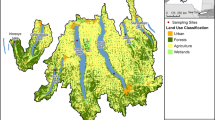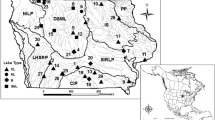Abstract
Mercury (Hg) contamination is widespread in the Laurentian Great Lakes region and is a serious environmental concern. In anaerobic environments such as lake sediments, mercury is transformed into methylmercury (MeHg) and can biomagnify up the food chain to toxic concentrations. The Great Lakes Fish Monitoring Program (GLFMP), administered by the US EPA Great Lakes National Program Office (GLNPO), aims to monitor temporal trends of mercury in the five Great Lakes using top predator fish as biomonitors. Total Hg (THg) concentrations were measured in Great Lake fish collected between 1999 and 2009. Single factor ANOVA determined that average fish THg concentrations over this time period in the five lakes were significantly different from one another in the order of Superior > Huron > Michigan > Ontario > Erie. By fitting the data to three different models (linear, quadratic, and two-segment piecewise), it was determined that Hg concentrations in top predator fish (lake trout, or walleye in Lake Erie) are currently increasing in Lake Erie and the Apostle Island sampling site in Lake Superior. Significant decreasing trends are evident in Lakes Michigan, Ontario, and the Rockport sampling site in Lake Huron, although all of the lakes exhibit elevated concentrations in fish compared to historic concentrations. As new Hg emission controls are implemented in the US, continued monitoring of Hg in Great Lakes fish will be needed to determine if they influence the current concentrations and trends.





Similar content being viewed by others
References
Bhavsar SP, Gewurtz SB, McGoldrick DJ, Keir MJ, Backus SM (2010) Changes in mercury levels in Great Lakes fish between 1970 s and 2007. Environ Sci Technol 44:3273–3279
Bignert A (2007) PIA statistical application developed for use by the Arctic Monitoring and Assessment Programme. www.amap.no
Bloom NS (1992) On the chemical form of mercury in edible fish and marine in vertebrate tissue. Can J Fish Aquat Sci 49:1010–1017
Burgess NM, Meyer MW (2008) Methylmercury exposure associated with reduced productivity in common loons. Ecotoxicology 17:83–91. doi:10.1007/s10646-007-0167-8
Butala SJM, Scanlan LP, Chaudhuri SN (2006) A detailed study of thermal decomposition, amalgamation/atomic absorption spectrophotometry methodology for the quantitative analysis of mercury in fish and hair. J Food Prot 69:2720–2728
Carlson DL, Swackhamer DL (2006) Results from the US Great Lakes Fish Monitoring Program and effects of lake processes on bioaccumulative contaminant concentrations. J Gt Lakes Res 32:370–385
Chalmers AT, Argue DM, Gay DA, Brigham ME, Schmitt CJ, Lorenz DL (2010) Mercury trends in fish from rivers and lakes in the United States, 1969–2005. Environ Monit Assess. doi:10.1007/s10661-010-1504-6
Cohen M, Artz R, Draxler R, Miller P, Poissant L, Niemi D et al (2004) Modeling the atmospheric transport and deposition of mercury to the Great Lakes. Environ Res 95:247–265. doi:10.1016/j.envres.2003.11.007
Connor WE (2000) Importance of n-3 fatty acids in health and disease. Am J Clin Nutr 71:171S–175S
Dastoor A, Larocque Y (2004) Global circulation of atmospheric mercury: a modeling study. Atmos Environ 38:147–162
Driscoll CT, Han YJ, Chen CY, Evers DC, Lambert KF, Holsen TM, Kamman NC, Munson RK (2007) Mercury contamination in forest and freshwater ecosystems in the northeastern United States. Bioscience 57:17–27
Eastern Research Group Inc. (2007) Report on the peer review workshop for Great Lakes Fish Monitoring Program—quality management plan and historical database. Great Lakes National Program Office. US EPA, Chicago
Evers DC, Kaplan JD, Meyer MW, Reaman PS, Braselton WE, Major A, Burgess N, Scheuhammer AM (1998) Geographic trend in mercury measured in common loon feathers and blood. Environ Toxicol Chem 17:173–183
Evers DC, Han YJ, Driscoll CT, Kamman NC, Goodale MW, Lambert KF, Holsen TM, Chen CY, Clair TA, Butler T (2007) Biological mercury hotspots in the northeastern United States and southeastern Canada. Bioscience 57:29–43
French TD, Jackson DA, Casselman JM, Scheider WA, Hayton A (2006) Long-term changes in legacy trace organic contaminants and mercury in Lake Ontario salmon in relation to source controls, trophodynamics, and climatic variability. Limnol Oceanogr 51:2794–2807
Harper CR, Jacobson TA (2001) The fats of life: the role of omega-3 fatty acids in the prevention of coronary heart disease. Arch Int Med 161:2185–2192
Henry KS, Kannan K, Nagy BW, Kevern NR, Zabik MJ, Giesy JP (1998) Concentrations and hazard assessment of organochlorine contaminants and mercury in smallmouth bass from a remote lake in the Upper Peninsula of Michigan. Arch Environ Contam Toxicol 34:81–86
Hogan L, Marschall E, Folt C, Stein R (2007) How non-native species in Lake Erie influence trophic transfer of mercury and lead to top predators. J Gt Lakes Res 33:46–61
Kerfoot WC, Harting SL, Rossmann R, Robbins JA (2002) Elemental mercury in copper, silver and gold ores: an unexpected contribution to Lake Superior sediments with global implications. Geochem Explor Environ Anal 2:185–202
Mackay D, Toose L (2004) Quantifying the fate of mercury in the Great Lakes Basin: toward an ecosystem approach. Environ Res 95:298–304. doi:10.1016/j.envres.2003.09.008
Marvin C, Painter S, Rossmann R (2004) Spatial and temporal patterns in mercury contamination in sediments of the Laurentian Great Lakes. Environ Res 95:351–362. doi:10.1016/j.envres.2003.09.007
Mergler K, Anderson HA, Chan LHM, Mahaffey KH, Murray M, Sakamoto M, Stern AH (2007) Methylmercury exposure and health effects in humans: a worldwide concern. Ambio 36:3–11
Mohapatra SP, Nikolova I, Mitchell A (2007) Managing mercury in the Great Lakes: an analytical review of abatement policies. J Environ Manag 83:80–92. doi:10.1016/j.jenvman.2006.01.015
Monson BA (2009) Trend reversal of mercury concentrations in piscivorous fish from Minnesota lakes: 1982–2006. Environ Sci Technol 43:1750–1755
Murray M, Holmes SA (2004) Assessment of mercury emissions inventories for the Great Lakes states. Environ Res 95:282–297. doi:10.1016/j.envres.2004.02.007
National Research Council (2000) Toxicological effects of methylmercury. National Academy Press, Washington, p 344
Pacyna EG, Pacyna JM, Steenhuisen F, Wilson S (2006) Global anthropogenic mercury emission inventory for 2000. Atmos Environ 40:4048–4063
Pickhardt PC, Folt CL, Chen CY, Klaue B, Blum JD (2002) Algal blooms reduce the uptake of toxic methylmercury in freshwater foodwebs. Proc Natl Adad Sci 99:4419–4423
Pirrone N, Allegrini I, Keeler GJ, Nriagu JO, Rossmann R, Robbins JA (1998) Historical atmospheric mercury emissions and depositions in North America compared to mercury accumulations in sedimentary records. Atmos Environ 32:929–940
Raymond B, Rossmann R (2009) Total and methyl mercury accumulation in 1994–1995 Lake Michigan lake trout and forage fish. J Gt Lakes Res 35:438–446. doi:10.1016/j.jglr.2009.05.004
Rossmann R (1999) Horizontal and vertical distributions of mercury in 1983 Lake Superior sediments with estimates of storage and mass flux. J Gt Lakes Res 25:683–696
Schmitt CJ, Brumbaugh WG (1990) National contaminant biomonitoring program: concentrations of arsenic, cadmium, copper, lead, mercury, selenium, and zinc in US freshwater fish, 1976–1984. Arch Environ Contam Toxicol 19:731–747
Selin NE, Sunderland EM, Knightes CD, Mason RP (2010) Sources of mercury exposure for US seafood consumers: implications for policy. Environ Health Perspect 118:137–143. doi:10.1289/ehp.0900811
Slemr F, Brunke E, Ebinghaus R, Temme C, Munthe J, Wangberg I et al (2003) Worldwide trend of atmospheric mercury since 1977. Geophys Res Lett 30:1516–1519. doi:10.1029/2003GL016954
Tripp L, Thorleifson M (1998) The Canadian mercury cell chlor-alkali industry: mercury emissions and status of facilities, 1935–1996. Report to Transboundary Air Issues Branch. Environment Canada, Hull
Tripp L, Bender T, Niemi D (2004) Assessing Canadian inventories to understand the environmental impacts of mercury releases to the Great Lakes region. Environ Res 95:266–271
Trudel M, Rasmussen JB (1997) Modeling the elimination of mercury by fish. Environ Sci Technol 31:1716
United States Environmental Protection Agency (1997) Mercury study report to Congress. EPA-452/R-97-003, Washington DC
Weis IM (2004) Mercury concentrations in fish from Canadian Great Lakes areas of concern: an analysis of data from the Canadian Department of Environment database. Environ Res 95:341–350. doi:10.1016/j.envres.2004.01.013
Wiener JG, Krabbenhoft DP, Heinz GH, Scheuhammer AM (2002) Ecotoxicology of mercury. In: Hoffman DJ, Rattner BA, Burton GA Jr, Cairns J Jr (eds) Handbook of ecotoxicology, 2nd edn. CRC Press, Boca Raton
Acknowledgments
The authors would like to thank Marylin Mayer for her contribution to analytical method development and 2004–2005 data; GLFMP Manager Elizabeth Murphy; Molly Middlebrook of CSC; Kenneth Miller for intricate data review; Xiaoyan Xia for help cataloging and organizing fish samples, and for continuous constructive project input; and Jiaoyan Huang for help with statistical analysis. In addition we would like to acknowledge the fish collection teams from both federal and state agencies, and all other collaborators from across several universities. We thank our peer reviewers for their guidance with earlier manuscript versions. Funding for this work was provided by the Great Lakes National Program Office under the United States Environmental Protection Agency, grant no. GL 96594201. Although the research described in this work has been partly funded by the US EPA, it has not been subjected to the agency’s required peer and policy review and therefore does not necessarily reflect the views of the agency and no official endorsement should be inferred.
Author information
Authors and Affiliations
Corresponding author
Rights and permissions
About this article
Cite this article
Zananski, T.J., Holsen, T.M., Hopke, P.K. et al. Mercury temporal trends in top predator fish of the Laurentian Great Lakes. Ecotoxicology 20, 1568–1576 (2011). https://doi.org/10.1007/s10646-011-0751-9
Accepted:
Published:
Issue Date:
DOI: https://doi.org/10.1007/s10646-011-0751-9




